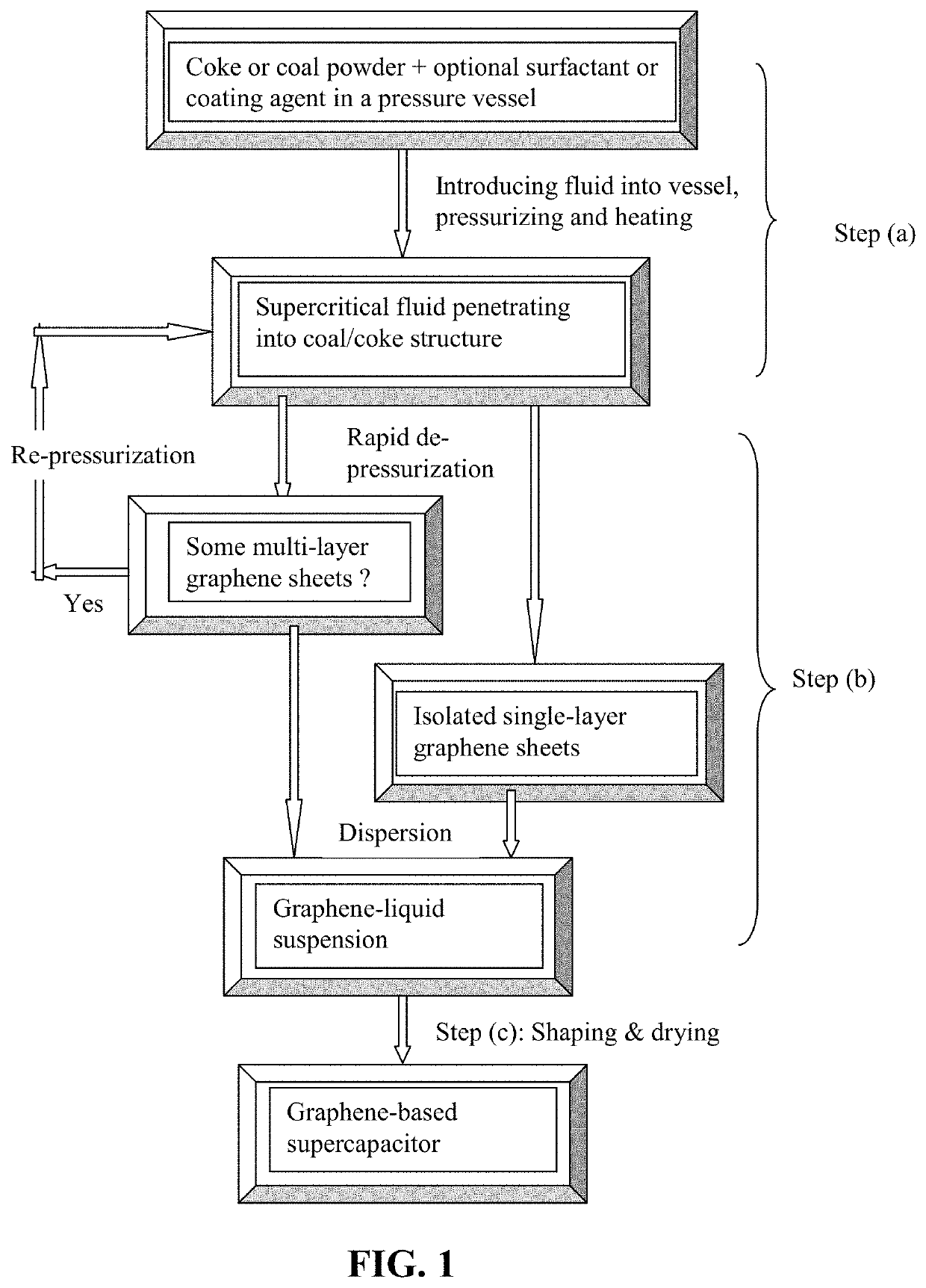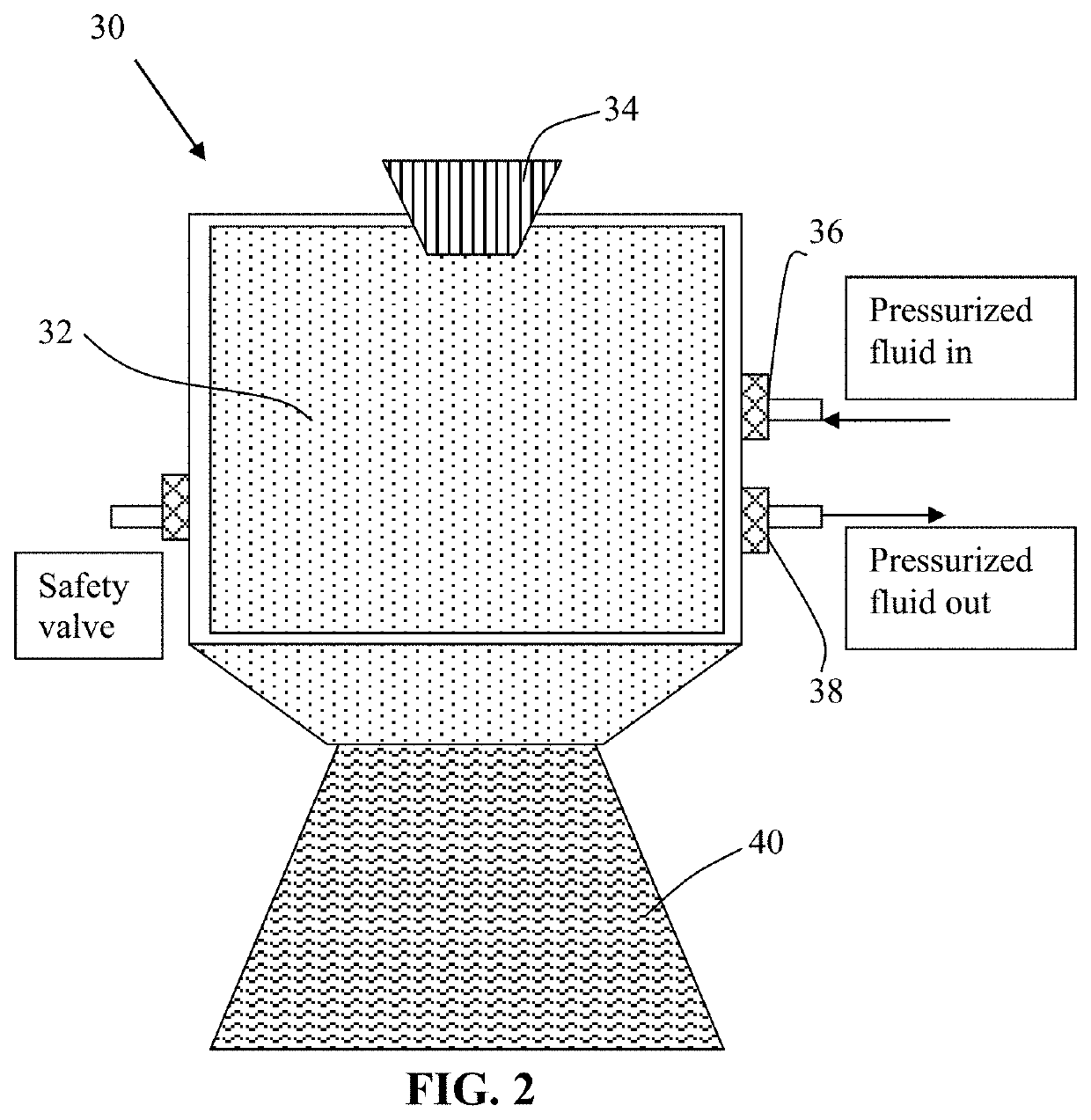Supercritical fluid production of graphene-based supercapacitor electrode from coke or coal
a supercapacitor electrode and graphene-based technology, which is applied in the direction of single-layer graphene, cell components, batteries, etc., to achieve the effect of reducing the thickness of a graphene sheet or the number of graphene planes
- Summary
- Abstract
- Description
- Claims
- Application Information
AI Technical Summary
Benefits of technology
Problems solved by technology
Method used
Image
Examples
example 1
n of Isolated Graphene Sheets from Milled Coal-Derived Needle Coke Powder
[0134]Needle coke, milled to an average length 2 by way of piping means and controlled or regulated by valves. A heating jacket was wrapped around the vessel to achieve and maintain the critical temperature of carbon dioxide. High-pressure carbon dioxide was introduced into the vessel and maintained at approximately 1,100 psig (7.58 MPa). Subsequently, the vessel was heated to about 70° C. at which the supercritical conditions of carbon dioxide were achieved and maintained for about 3 hours, allowing CO2 to diffuse into inter-graphene spaces and / or the amorphous zones between graphene domains. Then, the vessel was immediately depressurized “catastrophically” at a rate of about 3 milliliters per second. This was accomplished by opening a connected blow-off valve of the vessel. As a result, exfoliated graphene layers were formed, which were found to have an average thickness less than 1.0 nm. Various samples were...
example 4
n of Isolated Graphene Sheets and Graphene Electrodes from Milled Petroleum Needle Coke Powder
[0148]Needle coke, milled to an average length 2 gas through pipe means as in Example 1. The pressure at approximately 8.5 MPa was maintained while the vessel was heated to about 70° C. to achieve a supercritical condition of carbon dioxide. This intercalation process was conducted for about 1 hour, followed by a sudden depressurization to the ambient pressure. The resulting expanded / exfoliated structure after the initial cycle was investigated using AFM, SEM, and BET measurements. The NGPs obtained were found to have an average thickness of 1.3 nm. The intercalation and exfoliation steps were repeated for another cycle and the resulting graphene sheets are all single-layer or double-layer.
[0149]A small amount of polyethylene oxide (PEO / graphene ratio=1 / 20 by weight) was added into the water suspension containing graphene sheets after mechanical shearing. The suspension was extruded into fi...
example 5
Electrodes from Milled Lignite Coal Powder
[0150]In one example, samples of two grams each of lignite coal were milled down to an average diameter of 25.6 μm. The powder samples were subjected to ethanol-based supercritical fluid treatments: 514° K and 6.4 MPa, followed by rapid de-pressurization. The resulting graphene sheets exhibit a thickness ranging from single-layer graphene sheets to 3-layer graphene sheets based on SEM and TEM observations. The resulting suspension was cast into films and then heat-treated at 100° C. for 1 hour and then 350° C. for 4 hours to produce sheets of graphene foam. The specific capacitance of these sheets of foam was found to be 175-210 F / g.
Example 6: Production of Isolated Graphene Sheets and Graphene Electrodes from Anthracite Coal
[0151]Taixi coal from Shanxi, China was used as the starting material for the preparation of isolated graphene sheets and graphene electrodes. The raw coal was ground and sieved to a powder with an average particle size ...
PUM
| Property | Measurement | Unit |
|---|---|---|
| specific surface area | aaaaa | aaaaa |
| specific surface area | aaaaa | aaaaa |
| thickness | aaaaa | aaaaa |
Abstract
Description
Claims
Application Information
 Login to View More
Login to View More - R&D
- Intellectual Property
- Life Sciences
- Materials
- Tech Scout
- Unparalleled Data Quality
- Higher Quality Content
- 60% Fewer Hallucinations
Browse by: Latest US Patents, China's latest patents, Technical Efficacy Thesaurus, Application Domain, Technology Topic, Popular Technical Reports.
© 2025 PatSnap. All rights reserved.Legal|Privacy policy|Modern Slavery Act Transparency Statement|Sitemap|About US| Contact US: help@patsnap.com



